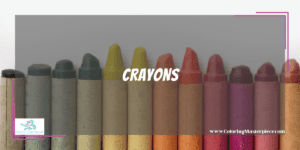Crayons and colored pencils are staples in the art arena for both the inexperienced as well as the professional artist. Peruse any art festival or street show and you will likely encounter amazing pieces made from each medium. The more an artist becomes familiar with different tools of the trade, the more likely they are to develop preferences based on the type of artwork they are creating and the desired effects of the instrument of choice.
Crayons vs. colored pencils for drawing comes down to preference. If you are looking to draw meticulous finely detailed drawings, colored pencils would be the obvious selection. However, if bold, broader strokes and more coverage are desired, crayons should be your creative tool of choice. In the end, both mediums have the quality to produce beautiful eye-pleasing artwork.
In one aspect, comparing crayons to colored pencils is like comparing a compact car to an SUV. Both are vehicles and have similar functions, but perform differently and have varied capacities. Crayons and colored pencils are similar in that they have similar ingredients including wax, pigment, and binders, but the ratios of each vary providing different textures and consistencies when used for drawing.
Crayons and colored pencils also have similar price points, from entry-level to professional grade. Some people choose to start with a lower price point before making a more definitive investment, while others decide to go all-in and invest in higher-quality tools. The choice is up to you. We are going to explore the similarities and differences between crayons and colored pencils to help you decide which one is most suitable for your art creation.
Crayons

If you think back to your earliest experiences with drawing, more than likely crayons will be a vivid part of those memories. Crayons are a standard in classrooms and craft rooms across the continents. They are widely available at big box stores, craft stores, and through dozens of online vendors, and they come in a wide variety of colors suited for all of your drawing needs. Most crayons are typically budget-friendly. Even professional-grade crayons, if you choose to go that route, will not break the bank. Check the clearance sales of your local stores after the back-to-school season for bargain deals!
Since crayons tend to have a higher ratio of wax compared to their other ingredients, they tend to have a softer and waxier consistency. When drawing with crayons, the lines and curves created by the crayon can appear pixelated or speckled because of the nature of the bond between the crayon materials and the paper. Because of the pixelated appearance, an artist drawing with crayons can use this to their benefit when creating backgrounds making them appear to be blurred or out of focus.
As with any medium, practice is the key. The longer that you experiment with your crayons, the more familiar you will become with their behaviors and capabilities. Some widely known artists work almost exclusively with crayons and create extremely realistic drawings that rival much-admired canvas paintings because of their depth and detail. If you’re thinking you want to start with crayons, we want to help set you up for success. We’ve put together some of our best tips to ensure an enjoyable process and pleasing results for your crayon drawings.
Tips:
-
- Use good-quality crayons. Crayola brand tends to be the standard for beginners, but many professionals also prefer them.
- Treat the crayon like the fine tool that it is. Make sure your grasp is firm but not too firm, and keep your wrist loose to allow free movement.
- When adding layers, do so gradually as crayon tends to be difficult to remove once applied.
- Make sure you have a good sharpener on hand to keep a nice tip on your crayon.
- Heat the crayon or paper with a hairdryer or similar heat source to soften the wax in the crayon to create a smoother finish.
- Use a toothpick or pin to scrape away layers of crayon to create hair, fur, feathers, or landscape features.
- Use baby oil or alcohol to blend and create a smoother finish.
- Use quilt batting or cotton balls to buff the surface of your crayon drawing to create a shiny finish.
Colored Pencils

Colored pencils come in a wide array of colors and options similar to crayons. They are capable of providing sleek, narrow lines with a freshly sharpened tip and once the tip has worn down a bit can provide broader muted lines. Although crayons tend to be the go-to for beginners, colored pencils typically have less of a learning curve to provide good coverage and continuous lines. Colored pencils can take longer to lay down layers of color; however, what it lacked in speed is made up for in the detail that can be achieved.
Whether you are drawing an abstract piece or a photorealistic one, colored pencils have the versatility and ease of use to provide an overall pleasant experience and satisfying result. Basic school grade-colored pencils are a great option for the beginner. They are inexpensive and widely available at local big box and craft stores as well as online retailers. Craft and artist supply stores will likely also have higher quality-colored pencils, called an artist or professional grade that may provide an even better drawing experience and more satisfying results.
To ensure a pleasing drawing experience and maximal results with your colored pencils, we have put together our best tricks and tips for you to try out as you create your artwork.
Tips:
-
- For layering, start with the lightest color first, then move on to darker colors.
- Use textured paper and less pressure to allow the background paper to show through for depth and dimension.
- Keep a good sharpener nearby to maintain a pointy tip for detail work.
- Use baby oil or rubbing alcohol on a cotton swab to smudge and blend colors.
- Use other mediums such as markers or crayons in conjunction with your colored pencils to create an interesting mixed-media piece.
- To take care of wax bloom (splotchy light areas that may appear on your drawing more typically with darker pigmented colors), wipe them down with a clean dry cloth.
- To preserve your colored pencil drawing, seal it with a spray fixative to ensure its longevity for years to come.
Surfaces
We just want to touch on the options of surfaces available for your drawings. Copy or printer paper is widely available and inexpensive and is a great starting point. Artist-grade paper or watercolor paper is textured paper that will naturally create some interest as the background shows through. Canvas is another option. You may want to prepare the canvas with canvas primer before you start to ensure that your medium of choice, either crayon or colored pencil, shows up better.
Don’t be afraid to experiment with other surfaces as well. A good piece of sanded wood that has been prepared ahead of time is worth trying, or any other surface that your crayons or colored pencils would be able to adhere to. Have you heard of the rock art craze? Painting rocks and leaving them for others to find? Typically paint is used, but there is certainly no reason that you couldn’t paint a base layer on the rock for a good foundation and then draw your design with crayons or colored pencils. If you are going to leave the decorated rocks outside, you may want to seal them to protect them from the elements.
Check out our blending tips HERE.
Final Thoughts
As beauty is in the eye of the beholder, one’s eye may be drawn more towards the crayon drawings, while another’s eye may favor the colored pencil drawing. As you can tell by now, regarding the question of crayons vs. colored pencils, there is no wrong answer, only preference. Whichever you choose to use for your drawings, whether crayon or colored pencil, it will be the right one for you! Don’t let indecision hinder your creativity. Make your selection and jump right in. Once your first piece is completed, perhaps you will want to switch and try out the other medium, or combine both mediums for an art piece as unique as you are!
Frequently Asked Questions
How do I know which crayon is best for me?
If you’re just starting, you may want to start with standard school-grade crayons such as Crayola. They come in a variety of colors and quantities. Or, if you want to jump right in and make more of an investment, choose artist or professional-grade crayons that are more tailored for the serious artist.
How do I choose the right colored pencils for my artwork?
Colored pencils come in a wide variety of preferences. Some are softer and some are harder. Some are even erasable. Determine what type of drawings you wish to create, and then browse your local artist supply store and ask advice from a sales associate to help you make an informed decision. Online retailers that offer customer reviews of products may also help make your decision.
Maximize the benefits of coloring with my free adult coloring eBook and by signing up for my email newsletter HERE!
Disclaimer: The information provided by ColoringMasterpiece.com (“The Site”) is for general informational purposes only. All information on the Site is provided in good faith, however, we make no representation or warranty of any kind, express or implied, regarding the accuracy, adequacy, validity, reliability, availability, or completeness of any information on the Site. Under no circumstance shall we have any liability to you for any loss or damage of any kind incurred as a result of the use of the Site or Reliance on any information provided on the Site. Your use of the Site and your reliance on any information on the Site is solely at your own risk. This blog post is for educational purposes only and does not constitute legal advice. Please consult a legal expert to address your specific needs.
Terms and Conditions: https://coloringmasterpiece.com/terms-and-conditions/
